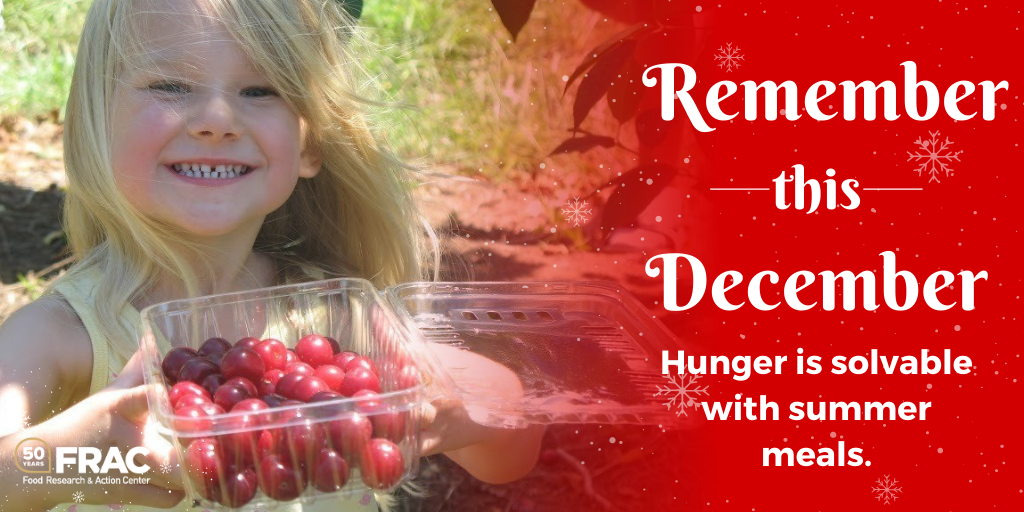December 21, 2020
During the holidays and all year long, millions of individuals and families who struggle against hunger are able to access healthy food with support from the federal nutrition programs. This year, the federal nutrition programs have played a critical role in ensuring people can continue to put food on the table during the twin COVID-19 public health and economic crises.
To celebrate the nation’s nutrition safety net, FRAC is releasing a seven-part “Remember This December” series that will highlight the impact of seven important federal nutrition programs.
This is the sixth installment of the series, which focuses on summer meals. Read the previous installment on WIC.

Expanding the reach of the Summer Nutrition Programs was more critical than ever this year as communities responded to the impacts of COVID-19. While summer is historically a difficult time for families that rely on school meals, unprecedented rates of food insecurity and unemployment due to the pandemic highlight the importance of increasing access to summer meals.
This year, schools and community-based organizations turned to the Summer Nutrition Programs when schools were shuttered due to the pandemic. To support access while maintaining safety and social distancing, the U.S. Department of Agriculture (USDA) issued many national and state waivers for the Summer Nutrition Programs.
As a result of these program flexibilities and community collaborations, innovative summer meal programs were implemented in communities across the country this past spring and summer, and meals remain available this school year. School districts, YMCAs, Boys & Girls Clubs, parks and recreation centers, and other community locations stepped up to provide summer meals to children in a variety of ways, including delivering directly to homes, providing meals at pick-up or drive-through locations, or providing meals onsite where programming was possible.
Dive into the key facts below about summer meals:
- Summer meals provide much-needed nutrition for millions of children: On an average day in July 2019, the Summer Nutrition Programs served nearly 2.8 million children.
- Summer meals and summer programs combined will be needed to counter the educational inequities that the pandemic is exacerbating. During normal times, summer meals sites that offer educational and enrichment activities when children are able to congregate, andprovide children with what they need: activities that keep them learning throughout the summer and nutrition that allows them to return to school in the fall healthy and ready to learn.
- Summer meals fuel children’s minds and bodies: The Summer Nutrition Programs contribute to children’s healthy growth and development by providing access to nutritious meals and snacks during the summer — a time when children can be more at risk for hunger and weight gain.
- Summer meals matter in your community: Summer Nutrition Programs operate in communities across the country, ensuring children 18 and under throughout the country are fed, learning, active, and safe during the summer months. Meal sites can be located at hospitals, libraries, schools, faith-based organizations, YMCAs, and more.
Learn more about summer meals at FRAC.org, and share our “Remember This December” summer meals graphic.
Click to tweet: #RememberthisDecember that hunger is solvable with #summermeals. Check out the latest FRAC Chat: http://bit.ly/3h7Zcq0
Watch our video on the importance of the federal nutrition programs.

